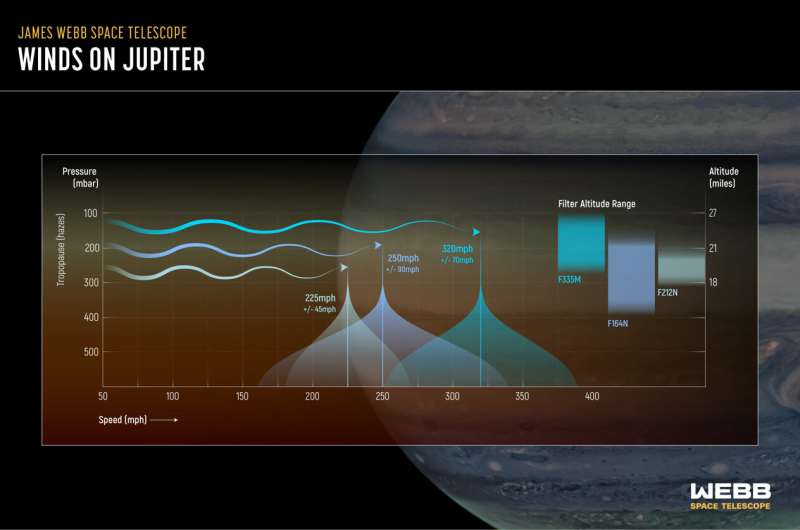Webb discovers new feature in Jupiter’s atmosphere
- October 19, 2023
- 0
Jupiter has some of the most distinctive atmospheric features in our solar system. The planet’s Great Red Spot, large enough to encircle the Earth, is almost as famous
Jupiter has some of the most distinctive atmospheric features in our solar system. The planet’s Great Red Spot, large enough to encircle the Earth, is almost as famous

Jupiter has some of the most distinctive atmospheric features in our solar system. The planet’s Great Red Spot, large enough to encircle the Earth, is almost as famous as some of the various rivers and mountains on the planet we call home.
But like Earth, Jupiter is constantly changing, and we still have a lot to learn about the planet. NASA’s James Webb Space Telescope is solving some of these mysteries and revealing new features of Jupiter we’ve never seen before; this includes a high-speed jet flying over the planet’s equator.
While the jet stream isn’t as visually obvious or striking as some of Jupiter’s other features, it gives researchers incredible insight into how the layers of the planet’s atmosphere interact with each other and how Webb will aid these studies in the future.
NASA’s James Webb Space Telescope has discovered a new, never-before-seen feature in Jupiter’s atmosphere. The high-speed jet stream, more than 3,000 miles (4,800 kilometers) wide, is located above Jupiter’s equator, above the main cloud layers. The discovery of this jet sheds light on how the layers of Jupiter’s famously turbulent atmosphere interact with each other and how Webb was able to uniquely track these features.
“This is something that completely surprised us,” said Ricardo Hueso of the University of the Basque Country in Bilbao, Spain, lead author of the paper describing the findings. “What we always saw as murky mists in Jupiter’s atmosphere are now emerging as distinct features where we can follow the planet’s rapid rotation.”
The research team analyzed Webb’s NIRCam (Near Infrared Camera) data taken in July 2022. The Early Release Science program, co-led by Imke de Pater of the University of California at Berkeley and Thierry Fouche of the Paris Observatory, was designed to capture images of Jupiter at 10-hour intervals, or one Jupiter day, using four different images. filters, each uniquely capable of detecting changes in small details at different altitudes in Jupiter’s atmosphere.
“While various ground-based telescopes, spacecraft such as NASA’s Juno and Cassini, and the Hubble Space Telescope have observed the changing weather conditions of the Jupiter system, Webb has already provided new information about Jupiter’s rings, moons, and atmosphere.” said. pater. .
Although Jupiter differs from Earth in many ways (Jupiter is a gas giant, Earth is a rocky world with a temperate climate), both planets have layered atmospheres. Infrared, visible, radio and ultraviolet radiation observed by these other missions reveals lower, deeper layers of the planet’s atmosphere, home to giant storms and ammonia ice clouds.

Webb, on the other hand, is looking further into the near infrared than before, sensitive to atmospheric layers at higher altitudes, about 15 to 30 miles (25 to 50 kilometers) above Jupiter’s cloud tops. In the near-infrared range, high-altitude nebulae often appear blurry, with increased brightness in the equatorial region. With Webb, finer details stand out within a bright, hazy band.
The newly discovered jet stream moves at about 320 miles per hour (515 kilometers per hour); this is twice the sustained winds of a Category 5 hurricane on Earth. It is located in Jupiter’s lower stratosphere, about 25 miles (40 kilometers) above the clouds.
By comparing the winds Webb observed at high altitudes with the winds Hubble observed in deeper layers, the team was able to measure how quickly winds change with altitude, creating wind shifts.
Webb’s superior resolution and wavelength coverage enabled the detection of small cloud features used to track the jet, while additional Hubble observations made a day after Webb’s observations helped determine the ground state of Jupiter’s equatorial atmosphere and the evolution of convective storms at Jupiter’s equator. It was also of critical importance in monitoring the It has nothing to do with jet.
“We knew that the different wavelengths of Webb and Hubble would reveal the three-dimensional structure of storm clouds, but we were also able to use time-lapse data to see how quickly storms were developing,” added team member Michael Wong. California, Berkeley. Berkeley, California, which conducted the relevant Hubble observations.
Researchers are looking forward to additional observations of Jupiter with Webb to determine whether the aircraft’s speed and altitude have changed over time.
“Jupiter has a complex but repeatable pattern of winds and temperatures in the equatorial stratosphere, far above winds in clouds and hazes measured at these wavelengths,” explained team member Leigh Fletcher from the University of Leicester in the United Kingdom. “If the strength of this new jet is related to this oscillating stratospheric pattern, we can expect the jet to change significantly over the next 2-4 years – it will be very interesting to test this theory in the coming years.”
“After years of tracking Jupiter’s clouds and winds from numerous observatories, it is surprising to me that we still have so much to learn about Jupiter, and that objects like this jet may remain hidden from view until these new NIRCam images are taken in 2022,” Fletcher continued. ” . Source
Source: Port Altele
As an experienced journalist and author, Mary has been reporting on the latest news and trends for over 5 years. With a passion for uncovering the stories behind the headlines, Mary has earned a reputation as a trusted voice in the world of journalism. Her writing style is insightful, engaging and thought-provoking, as she takes a deep dive into the most pressing issues of our time.